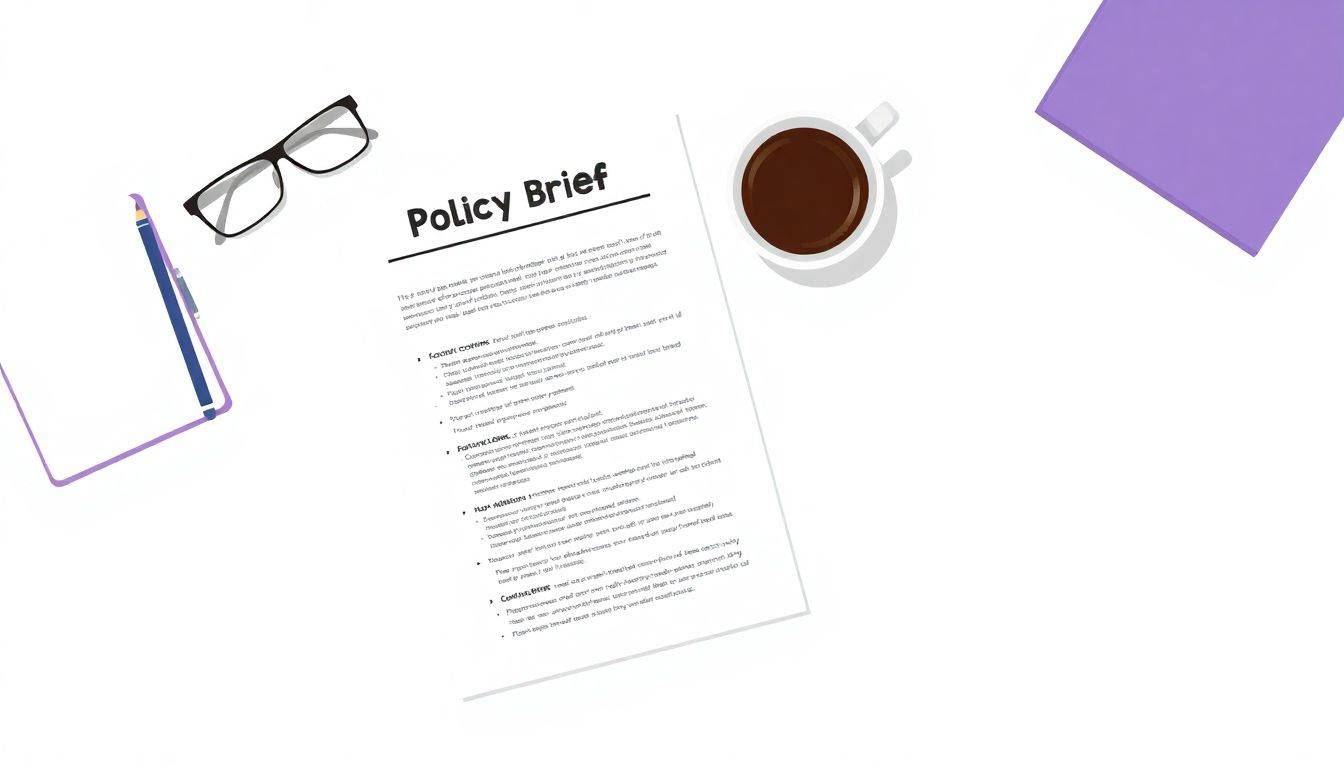Writing a policy brief can feel like trying to solve a puzzle without all the pieces, right? It’s tricky to know where to start and how to make your point clear.
Don’t worry, though! By the time you’re done here, you’ll have a clear roadmap to crafting an effective policy brief that actually gets read.
Let’s dive in and make policy brief writing a breeze.
Key Takeaways
- A policy brief is a concise document that explains a critical issue and offers evidence-based recommendations for busy policymakers.
- Identify your target audience and tailor the brief to their needs, using simple language and keeping it under 700 words.
- Plan carefully by defining the problem, outlining key points, and deciding on supporting evidence, focusing on a single topic.
- Use a clear structure with an executive summary, background information, analysis, and actionable recommendations.
- Write clearly and concisely, avoiding jargon and unnecessary details; make every sentence count.
- Format the brief effectively with headings, bullet points, and visuals to enhance readability; proofread thoroughly.
- Share your brief strategically with the right stakeholders and utilize networking to increase its impact.

1. Understand How to Write Policy Briefs
Writing a policy brief might seem daunting at first, but it’s all about conveying important information in a clear and concise manner. A policy brief is a short, focused document that explains the urgency and importance of a specific issue and provides evidence-based recommendations.
In essence, a policy brief communicates key findings and proposes actionable solutions to policymakers who may not have time to wade through lengthy reports.
Given that policymakers often work long hours—from 6 am to 9 pm—and may have 15 to 20 meetings a day on different topics, they rely on policy briefs to quickly get up to speed on an issue. In fact, internal government policy briefs tend to be no more than one to two pages long, and policymakers primarily look at the executive summary to decide whether to continue reading.
Understanding how to craft an effective policy brief is essential, especially since 40% of government relations professionals say briefing is a monthly task, 35% say it’s a weekly task, and 11% say it’s a daily task. So, mastering the art of writing policy briefs not only helps communicate your message effectively but also increases the chances that your recommendations will be heard and acted upon.
2. Identify Your Target Audience
Before you put pen to paper, it’s crucial to know who you’re writing for. Is your policy brief intended for government officials, non-profit organizations, or maybe business leaders? Understanding your target audience helps tailor your message to their interests and needs.
Consider their level of knowledge on the topic. Are they familiar with technical terms, or do they need things explained in simpler terms? Also, think about what motivates them. For instance, policymakers are often pressed for time, so keeping your brief concise—ideally 700 words or less—is key.
By tailoring your policy brief to your audience, you increase the likelihood that they’ll read it and, more importantly, act on your recommendations. Remember, a policy brief that resonates with its audience is more effective than one that doesn’t hit the mark.
3. Plan Your Policy Brief Carefully
Planning is everything when it comes to writing a policy brief. Start by clearly defining the problem you want to address and the main message you wish to convey. Outline the key points you need to cover, and decide on the evidence you’ll use to support your recommendations.
Utilizing the right tools can also streamline your planning process. For example, choosing the best word processor can make organizing your thoughts and structuring your brief much easier.
It’s helpful to create a rough structure before you start writing. This might include sections like an executive summary, background information, analysis or discussion, and your recommendations. Keeping your brief organized ensures that your readers can follow your argument without getting lost.
Also, consider incorporating visual elements like charts or graphs to illustrate your points. Studies have shown that visual aids can significantly enhance the effectiveness of a policy brief by making complex data easier to understand. If you’re dealing with complex information, using AI tools for data analysis can be a game-changer.
Don’t forget to keep your brief focused on a single topic. Avoid tangents and unnecessary details. Policymakers appreciate succinctness and clarity, so stick to the essential information that supports your main message.

4. Follow a Clear Structure for Your Brief
Having a clear structure is like giving your readers a roadmap—they’ll know exactly where to find the information they need. Start with an executive summary that encapsulates your main points. Remember, policymakers often decide whether to read further based on this section alone.
Next, provide some background information to set the context. Keep it brief but informative. Then, dive into your analysis or discussion, presenting evidence to support your arguments. Finally, conclude with actionable recommendations.
Since policymakers may have up to 20 meetings a day, they appreciate brevity and clarity. Keeping your policy brief organized not only makes it easier to read but also increases the chances that your message will get through. If you’re wondering about the best way to present your information, you might consider checking out some examples of concise writing for inspiration.
5. Use Clear and Concise Writing Style
Simplicity is your friend when writing a policy brief. Use clear and straightforward language to convey your message. Avoid jargon and technical terms unless you’re sure your audience is familiar with them.
Each sentence should serve a purpose. If it doesn’t add value, consider cutting it out. Remember, policy briefs are typically 700 words or less, so every word counts.
Short sentences and paragraphs make your brief more readable, especially for busy officials who are reading on the go. Imagine you’re explaining the issue to a friend over coffee—that’s the tone you want to achieve.
If you’re looking to refine your writing skills, you might find these writing prompts a fun way to practice clarity and brevity.
6. Format and Present Your Brief Effectively
First impressions matter. A well-formatted policy brief can grab attention and make your content more engaging. Use headings and bullet points to break up text and highlight key points.
Incorporate visual elements like charts, graphs, or infographics to illustrate your data. Visuals can significantly enhance understanding by making complex information more accessible.
Ensure your fonts are easy to read and professional. Stick to standard fonts and sizes. If you’re curious about which fonts work best, here’s a guide on the best fonts for professional documents.
Don’t forget to proofread. Typos and errors can undermine the credibility of your brief. Consider having a colleague review it or use proofreading software to catch any mistakes.
7. Share Your Policy Brief with the Right Audience
Once your policy brief is ready, it’s time to get it into the right hands. Identify the key stakeholders who have the power to act on your recommendations. This might include specific policymakers, department heads, or influential organizations.
Consider the best channels for distribution. Email might be efficient, but handing out physical copies at meetings or conferences can make a more lasting impression.
Networking can also play a significant role. Building relationships with decision-makers increases the likelihood that your brief will be read and considered. If you’re interested in expanding your network, here’s some advice on how to connect with professionals in your field.
Remember, a policy brief is only as effective as the action it inspires. By sharing it strategically, you enhance its potential impact.
FAQs
A policy brief should typically be 2 to 4 pages long. This length allows you to present key information concisely without overwhelming the reader with too much detail.
Consider who has the power to implement your recommendations. This could be policymakers, stakeholders, or specific organizations. Understanding their needs helps tailor your brief effectively.
A typical policy brief includes an executive summary, introduction, approach, results, and recommendations. Following this structure ensures clarity and logical flow of information.
Use clear language, provide evidence for your claims, and highlight the benefits of your recommendations. Tailoring your message to the audience’s interests also enhances persuasiveness.

